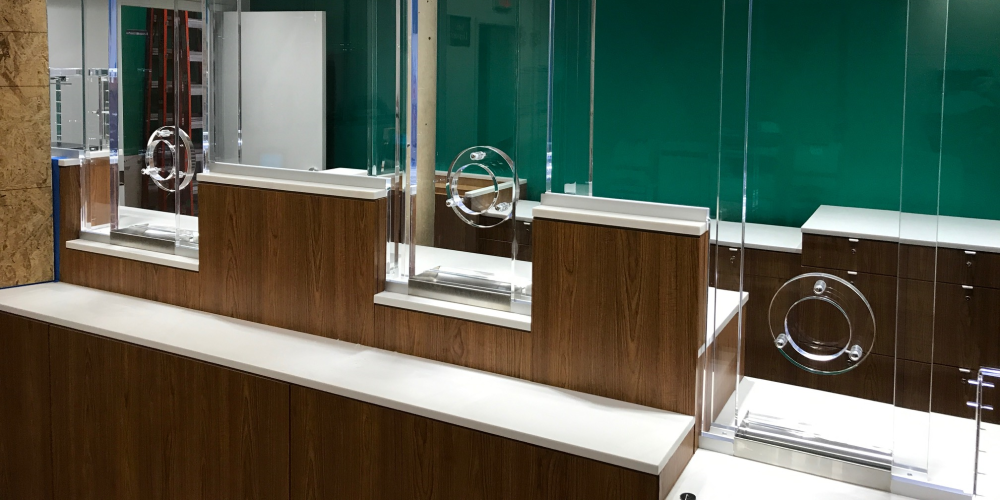Bullet-resistant transaction windows are the most common ballistic barrier in North America. They are cost-effective solutions that create a secure point-of-sale, reception area, checkpoint, or transaction area. They’re a great option for many facilities and a straightforward way for any builder to add enhanced security to their offerings.
Six Reasons to Use a Bullet-Resistant Transaction Windows
When you need to enhance employee protection, it can be difficult to design a system that doesn’t impede the flow of work. Transaction windows are excellent solutions for ballistic protection, and with the right design, your employees and customers will hardly notice the difference.
Here are some bullet-resistant transaction window facts that will help you choose the right design for your needs.
1. Bulletproof Transaction Windows Prevent Crime
By simply installing bullet-resistant transaction windows, you reduce the likelihood that anyone even attempts an attack. Would-be criminals tend to choose the path of least resistance so if they can see that there’s a barrier between them and the cash, they will likely look for more vulnerable targets.
2. Bulletproof Transaction Windows Aren’t Just for Stores
Anywhere employees interact with the public has the potential for safety concerns—and bullet-resistant transaction windows can improve their security. The types of industries that install ballistically rated transaction windows include government offices, banks, healthcare, law enforcement buildings, gas stations and convenience stores, event centers, and schools.
3. Transaction Windows Offer Customizable Levels of Protection
Any opening window provides a potential line of fire for an assailant. Most transaction windows include transaction accessories to safely exchange cash, paperwork, and small items. Currency trays are popular for banks and ticket booths. Package passers are a good choice for convenience stores, but they can take up a large amount of counter space. Transaction drawers fit under the counter and also work well for exterior transaction windows.
This article on pass-through boxes provides more details for securely exchanging small items.
Bullet-resistant sliding transaction windows are typically used for locations that experience high risk for a limited amount of time and need to exchange larger items. For example, a 24-hour business may leave the window open during the day, but keep the window closed for transactions that occur throughout the night. Some gas stations, restaurants, pharmacies, and concession stands utilize these types of bullet-resistant transaction windows.
4. Bulletproof Transaction Windows Facilitate Sound Transfer
A critical part of most transactions is verbal communication. Sound doesn’t move through bulletproof glass very well, but keeping sensitive personal and financial information secure is critical to the customer experience. The best solution in these situations is natural voice transfer. We offer a variety of voice port designs to facilitate sound transfer without creating a line of fire. For more information, check out our blog, Can You Hear Through Bulletproof Glass?
5. Transaction Window Can Be Installed Inside and Outside
Need to facilitate transactions outdoors? Not a problem! The TSS team can help you design a transaction window that meets your safety needs while providing protection from the elements. Some types of bulletproof glass are not rated for UV exposure, weathering, and more. Installing an interior-only window in an exterior setting could compromise the integrity of the bullet-resistant properties, rendering the window useless against ballistic assault. When you work with TSS, you can trust that our team will equip you with the right solution for your needs, including custom-fabricating exterior transaction windows that will stand the test of time.
6. Transaction Windows Are Highly Customizable
While TSS offers a standard range of transaction windows, it’s normal for customers to have special requirements. For example, we’ve previously designed a baffle-style window with extra spacing so that rolled up blueprints can be securely transferred between sides.
More recently, we’ve worked with a federal government agency that had previously used a different custom window style at every branch office. They partnered with us to design a custom bulletproof transaction window that fit their adjustable height workstations, clipboard document exchange, and sensitive information sound transfer. The result was so popular that we named it the Roxbury Window and added it to our list of standard transaction window products.
If you have unusual parameters for your bulletproof transaction windows, don’t hesitate to contact us to learn what our design team can do for you. Our team of experts has secured tens of thousands of buildings nationwide, and will gladly fine-tune a custom solution for your unique needs.
Contact TSS to Plan Your Bullet-Resistant Transaction Window Projects
When hardening your physical security, it’s easy to get lost in the sea of details. At TSS, we’re always happy to work with you to straighten out those details with simple solutions. Our security experts can help you narrow down the scope of your project, the critical points to secure in your facility, and the best products to achieve your security goals.
Contact our ballistic security experts if you have questions or want to get started with a bulletproof transaction window project.

